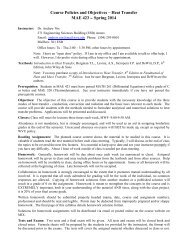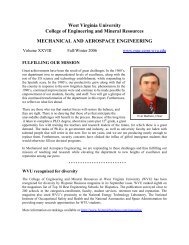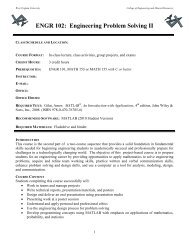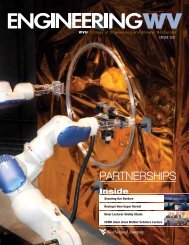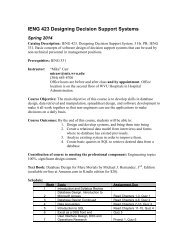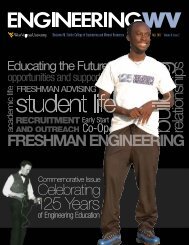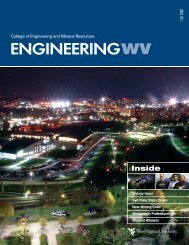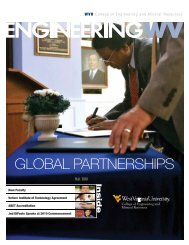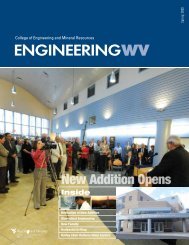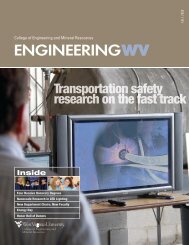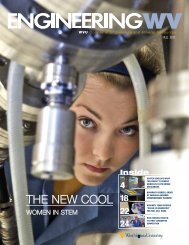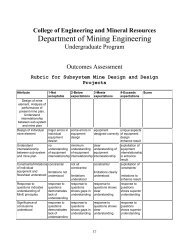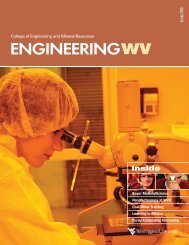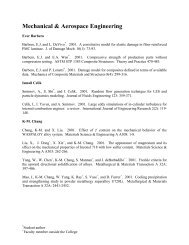70931, page 1-35 @ Normalize - WVU College of Engineering and ...
70931, page 1-35 @ Normalize - WVU College of Engineering and ...
70931, page 1-35 @ Normalize - WVU College of Engineering and ...
Create successful ePaper yourself
Turn your PDF publications into a flip-book with our unique Google optimized e-Paper software.
Student News<br />
Enrollment management<br />
services coordinator Migri<br />
Prucz (right) has been<br />
announcing the Pumpkin Drop<br />
teams from atop the<br />
<strong>Engineering</strong> Sciences Building<br />
for 19 years. Pr<strong>of</strong>essor Don<br />
Lyons (not pictured) emcees<br />
the event from the ground.<br />
Building A Better<br />
Helicopter<br />
By Shainna Sticklen<br />
With their ability to take <strong>of</strong>f <strong>and</strong> l<strong>and</strong> vertically from<br />
almost anywhere <strong>and</strong> hover in place, helicopters are<br />
widely used in for both civil <strong>and</strong> military flight<br />
operations. Researchers in our Department <strong>of</strong> Mechanical <strong>and</strong><br />
Aerospace <strong>Engineering</strong> are striving to make these rotary aircraft<br />
safer <strong>and</strong> more efficient.<br />
Gerald Angle, a doctoral student <strong>and</strong> research assistant in the<br />
department, has been working on the circulation control<br />
helicopter blade for about three years, along with his advisor,<br />
James Smith, mechanical <strong>and</strong> aerospace engineering pr<strong>of</strong>essor<br />
<strong>and</strong> director <strong>of</strong> <strong>WVU</strong>’s Center for Industrial Research<br />
Applications.<br />
“One <strong>of</strong> the most complex <strong>and</strong> maintenance intensive systems<br />
on a helicopter is the main rotor drive assembly <strong>and</strong> control<br />
system,” said Angle. “The main rotor blades are controlled by<br />
the swash plate, which alters the pitch <strong>of</strong> the main rotor blades<br />
during flight. The swash plate connects to the blades at their<br />
root <strong>and</strong> is controlled by the pilot to alter the aircraft’s pitch<br />
<strong>and</strong> direction. The mechanical nature <strong>of</strong> these motions requires<br />
constant inspection <strong>and</strong> maintenance, <strong>and</strong> also presents a major<br />
flight safety issue if failure occurs during flight.”<br />
Angle’s research involves applying circulation control<br />
techniques to aerodynamically change the lift coefficient <strong>of</strong> the<br />
rotor blade. The patent-pending concept involves blowing jets<br />
<strong>of</strong> air through slots on the rotor blade’s surface to alter the<br />
aerodynamic characteristics <strong>of</strong> the blade without physically<br />
changing the pitch <strong>of</strong> the blade, which will ultimately lead to<br />
the elimination <strong>of</strong> the swash plate.<br />
Nineteenth<br />
Pumpkin Drop<br />
RAISES MONEY FOR CHARITY<br />
More than 100 teams <strong>of</strong> elementary, high school, <strong>and</strong><br />
college students from all over the state competed in the<br />
19th Morgantown Pumpkin in October. Participants<br />
dropped their pumpkins, encased in packages they designed<br />
with everything from bungee cords to toilet paper rolls, from<br />
the 11-story <strong>Engineering</strong> Sciences Building. The team whose<br />
pumpkin got closest to the target without bursting was<br />
declared the winner. Wallace Venable, <strong>WVU</strong> emeritus associate<br />
pr<strong>of</strong>essor, measured distances.<br />
This year’s winning teams were from Doddridge County; St.<br />
Marys, West Virginia; <strong>and</strong> Suncrest Middle School.<br />
Registration fees raised raised $1,200 for the Ronald<br />
McDonald House in Morgantown, which provides lodging for<br />
families <strong>of</strong> hospitalized children. The <strong>WVU</strong> chapter <strong>of</strong> the<br />
American Society <strong>of</strong> Mechanical Engineers (ASME) sponsors<br />
the event <strong>and</strong> a similar one held in Charleston as well.<br />
“It’s always great to work with Ronald McDonald House,” said<br />
ASME chapter president Jonathan Painter. “This event also<br />
gives us an opportunity to work with young people, to show<br />
them what our pr<strong>of</strong>ession is all about, <strong>and</strong> to open their eyes<br />
to another world.”<br />
“We hope to get more lift out <strong>of</strong> a smaller rotor,” said Angle,<br />
“which would mean that a helicopter could carry the same load<br />
with a smaller l<strong>and</strong>ing area. One possible benefit, in addition to<br />
enhanced safety <strong>and</strong> reduced maintenance, is that the military<br />
might be able to park more helicopters on their ships.”<br />
26<br />
Spring 2007<br />
Jonathan Painter (left), ASME chair, <strong>and</strong> John Brewer, ASME<br />
vice chair (right) presented a check for $1,200 raised from the<br />
Pumpkin Drop to Kim George (center) <strong>of</strong> the Ronald McDonald<br />
House in Morgantown.



